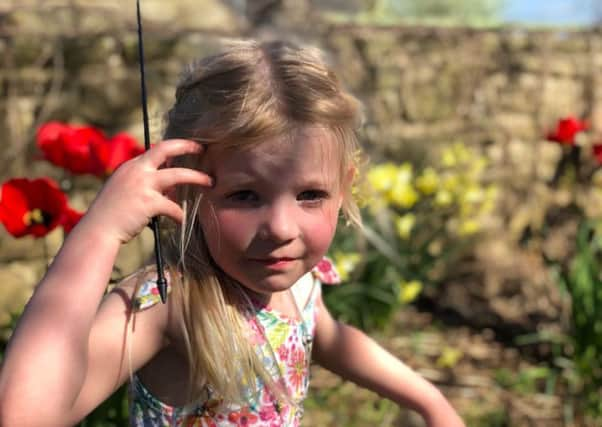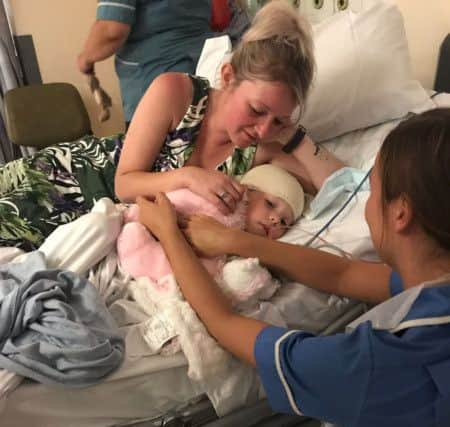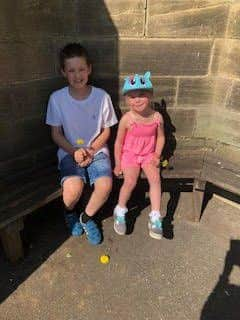Brave Queensbury girl Amelia fighting ultra-rare brain tumour


Little Amelia Elphee was diagnosed with cancer in June this year following the sudden onset of seizures.
She had what’s known as a ‘neuroepithelial’ brain tumour - one of only 30 known cases in Europe.
Advertisement
Hide AdAdvertisement
Hide AdIt was a devastating blow for mum Vicky Robinson and father Lewis, who were given the news “no parent ever expects to have to hear”.


But Amelia has already undergone a seven hour operation to successfully remove the growth, which was 2cm in size and located in the upper part of her brain.
She astounded medics and family with her courage and energy despite her extended stays in hospital.
Now Amelia is set to have proton beam therapy - a unique, less damaging form of radiotherapy - at a clinic in Europe after receiving vital funding from the NHS.
Advertisement
Hide AdAdvertisement
Hide AdAnd Vicky hopes the treatment will stop the insidious disease from ever returning.


Speaking as the family prepares to fly to Essen, Germany, in the coming days, she said: “When Amelia first suffered a seizure, I thought she may have simply overheated, or that she might have epilepsy.
“Never once did I think I’d be told she had cancer. To hear those words left me dumbstruck, numb. I just couldn’t take it in.
“But Amelia has been an inspiration throughout her treatment. She’s been so strong. In fact, when she woke up from surgery the first thing she said was, ‘Can I go to the playroom now?’
Advertisement
Hide AdAdvertisement
Hide Ad“And we’re optimistic of a successful outcome following proton beam therapy.
“We know we’re lucky to receive it through the NHS, and that many other families have to fight to get it.”
Unlike traditional X-ray radiotherapy - such as intensity modulated radiotherapy (IMRT) - proton therapy uses an accelerated ‘pencil beam’ of positively-charged particles, travelling at 100,000 miles per hour, to target the area with pin-point accuracy.
The x-rays used in conventional radiotherapy pass all the way through the body, which has the risk of damaging sensitive tissues around and behind the tumour site - in Amelia’s case, the brain.
Advertisement
Hide AdAdvertisement
Hide AdWhereas, in proton beam therapy, the particles stop at the tumour site, reducing radiation damage to nearby organs.
A recent Freedom of Information Request undertaken by the respected Proton Therapy Center in Prague revealed how the NHS has approved 737 patients to travel abroad for proton treatment since 2008.
Almost three quarters of those referred were children.
Vicky, a learning disability nurse and youth worker, says their worst nightmares were realised when she received a call at work from Amelia’s primary school, Russell Hall, to say she was unwell on June 20 this year.
Vicky, engaged to partner Michael Ellis, 30, said: “The headteacher said Amelia had been shaking but added, ‘There’s nothing to worry about, get here when you can’.
Advertisement
Hide AdAdvertisement
Hide Ad“I dropped everything and arrived just as the ambulance did. Of course, I was worried, but Amelia looked fine, just tired.”
Amelia was taken to Calderdale Royal Hospital where she began having another seizure in front of a paediatrician.
An initial MRI scan was performed the following day which revealed the root of the problem.
Vicky, who’s also mum to 11-year-old son Lewis, added: “A nurse came back with the results of the scan, along with a support worker, and we were taken into a private room.
Advertisement
Hide AdAdvertisement
Hide Ad“I automatically thought, ‘This is going to be something bad’. But I still wasn’t expecting anything as bad as the news we received
“The nurse said, ‘Amelia has a brain tumour’. I was with Amelia’s father, Lewis, and he broke down crying. I just went into shock. All I could say was, ‘What does that even mean?’
“At this point Amelia was driving around and around in a toy car outside, having fun, not a care in the world. It didn’t seem fair.”
Amelia was transferred to Leeds General Infirmary for a second MRI scan - while family and friends rallied round.
Advertisement
Hide AdAdvertisement
Hide AdVicky said: “As you can imagine, we were all hit hard. My son Lewis can be quite slow to process information. It took a while for the situation with his sister to really sink in.
“But he eventually told me, ‘I want to know what’s going on’. He was upset. He broke down in tears at school a few times with worry.
“The truth is, no-one can give you the answer to the question we all asked - ‘Is she going to die?’ You just have to stay strong and keep believing.
“Thankfully Amelia continues to amaze us all with her bravery.”
Advertisement
Hide AdAdvertisement
Hide AdAmelia underwent craniotomy surgery to remove the tumour on June 27 - just a week after she first began displaying symptoms - in a seven hour operation.
Encouragingly, surgeons were able to remove the entire tumour in one go.
Vicky added: “The fact the operation had been such a success was an unbelievable relief. Amelia was in a high dependency unit, a bandage around her head and hooked up to all these wires.
“But within five minutes of coming round from the anaesthetic, she said, ‘I want to go the the playroom.’ That was all she was bothered about! We took turns playing games with her for the rest of the evening.”
Advertisement
Hide AdAdvertisement
Hide AdTwo days later Amelia was back at home making another promising recovery.
Now Amelia is set to spend six weeks in Germany having proton therapy. While the treatment is funded, the cost of living there is not. So Vicky, who’s had to take time off work, set up a crowdfunding platform in order to raise the necessary money to continue the fight.
Remarkably, she raised more than £6,000 in a matter of days - thanks in part to donations from Leeds United fans, after Amelia’s football-mad granddad Alan Riley appealed to fellow supporters.
Vicky said: “We’re obviously nervous about what happens next. It’s going to be horrible being away from home for so long.
Advertisement
Hide AdAdvertisement
Hide Ad“But we’re all hopeful we can put an end to this nightmare once and for all.
“And I want to share what we’re going through, so that others in the same position can get the support they need, too.”
The next two years will see the opening of the NHS’s first ever proton beam cancer treatment centres - one at The Christie Hospital in Manchester and the other at London’s University College Hospital.
They’ll each be able to treat around 750 patients per year.
Advertisement
Hide AdAdvertisement
Hide AdLeading European oncologist Dr Jiri Kubes, medical director at the Proton Therapy Center in Prague, said: “While the NHS acknowledges the benefits of Proton Beam Therapy, and is building its own centres, they will still only be able to treat a fraction of those who might benefit from it, while many people will be turned down for the treatment because of the very limited indication criteria.
“There’s still a long way to go before patients in the UK have widespread access to it.
“But the general public is becoming increasingly aware of the benefits of Proton Beam Therapy.
“It’s highly effective in treating tumours in extremely sensitive areas of the human body and it has also been proved that proton therapy reduces the risk of secondary cancers by more than half, compared with traditional radiotherapy.”
To donate to Amelia’s plight: https://www.justgiving.com/crowdfunding/ameliaelphee.